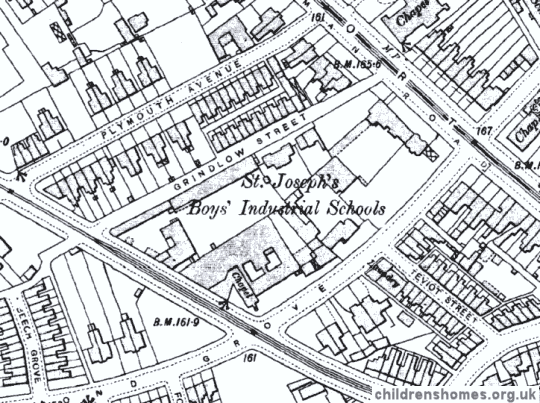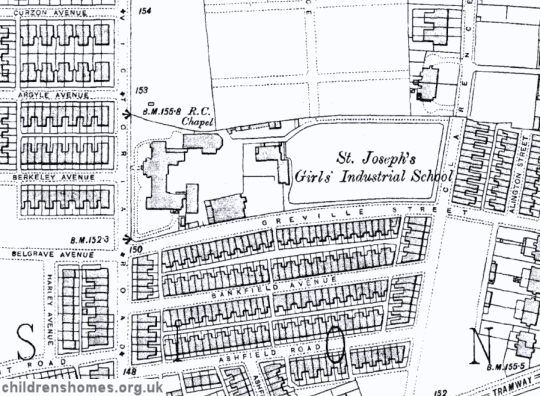St Joseph's Industrial School for Roman Catholic Girls, Manchester, Lancashire
On August 2nd, 1871, the St Joseph's Industrial School for Roman Catholic Girls officially came into operation at Grindlow House, 460 Stockport Road, Longsight, Manchester. Like the like the neighbouring St Joseph's Industrial School for Boys, the girl's establishment was founded and then superintended by the Rev. Thomas Quick. The girls' premises lay at the eastern side of the boys' School.
The location of the School site is shown on the 1908 map below.

St Joseph's Industrial School site, Manchester, c.1908.
The School could initially accommodate up to 40 girls. In addition to the Rev. Quick, the School's staff in 1872 comprised the Matron, Mrs Coppinger; a school mistress, Miss McKenna; a work mistress and a cook.
Major additions to the buildings in 1875-76 increased the accommodation to 80 places. The girls were taught needlework and knitting, and made all their own clothing. They also made and repaired clothing for the Boys' School, washed clothing in the laundry, and helped with the housework and in the kitchen.
In 1876, the Matron was Miss Holmes; the school mistress Miss O'Reilley; and the industrial teacher, Miss Quinn. A laundress and cook were also employed. The following year, the management of the institution was transferred to the Daughters of Charity of St Vincent de Paul, with Sister Mary Gunning becoming Superintendent, assisted by two other Sisters and ancillary staff.
In 1884, the Girls' School moved to new premises on Victoria Road (now Laindon Road), Rusholme, near Victoria Park The buildings were officially certified on September 2nd, 1884, to house up to 160 girls aged between 10 and 16.
The location of the home is shown on the 1908 map below.

St Joseph's Industrial School for Roman Catholic Girls site, Manchester, c.1908.
In around 1895, an Auxiliary Home was established at Agnew House, East Beach, Lytham. Every girl spent at least two weeks a year there.
In 1900, a new chapel and a new training home for the older girls were completed; the latter provided additional sleeping accommodation, a large workroom for the dressmakers, and a sitting room for the laundry girls. In 1911, a new porch entrance porch was erected together with a summer house in the garden.
The School enjoyed a very good reputation for the conduct of its inmates and their educational performance. The needlework done at the School was said to be unrivalled, with girls leaving the establishment being qualified for good places as costume makers. The laundry, too, was said to be admirable, giving training in hand and machine work and ranging from plain washing to the getting up of the finest materials. A visiting instructor taught the girls drill exercises.
In 1912, Sister Gunning was still in post as Superintendent, assisted by 11 Sisters of the Order of St Vincent de Paul, plus a number of lay assistants. The dentist was Mr Brook.
The School gave up its status as an Industrial School in 1922. The premises then continued in use as a convent and associated school, later becoming St Joseph's Roman Catholic High School for Girls. The site is now occupied by the modern houses of Tagore Close.
Records
Note: many repositories impose a closure period of up to 100 years for records identifying individuals. Before travelling a long distance, always check that the records you want to consult will be available.
- Daughters Of Charity Of St Vincent De Paul, Provincial House, The Ridgeway, Mill Hill, London NW7 1RE. (Archivist: Sister Bernadette Ryder DC) It is believed that no records survive.
Census
Bibliography
- Higginbotham, Peter Children's Homes: A History of Institutional Care for Britain's Young (2017, Pen & Sword)
- Mahood, Linda Policing Gender, Class and Family: Britain, 1850-1940 (1995, Univeristy of Alberta Press)
- Prahms, Wendy Newcastle Ragged and Industrial School (2006, The History Press)
Links
Except where indicated, this page () © Peter Higginbotham. Contents may not be reproduced without permission.


